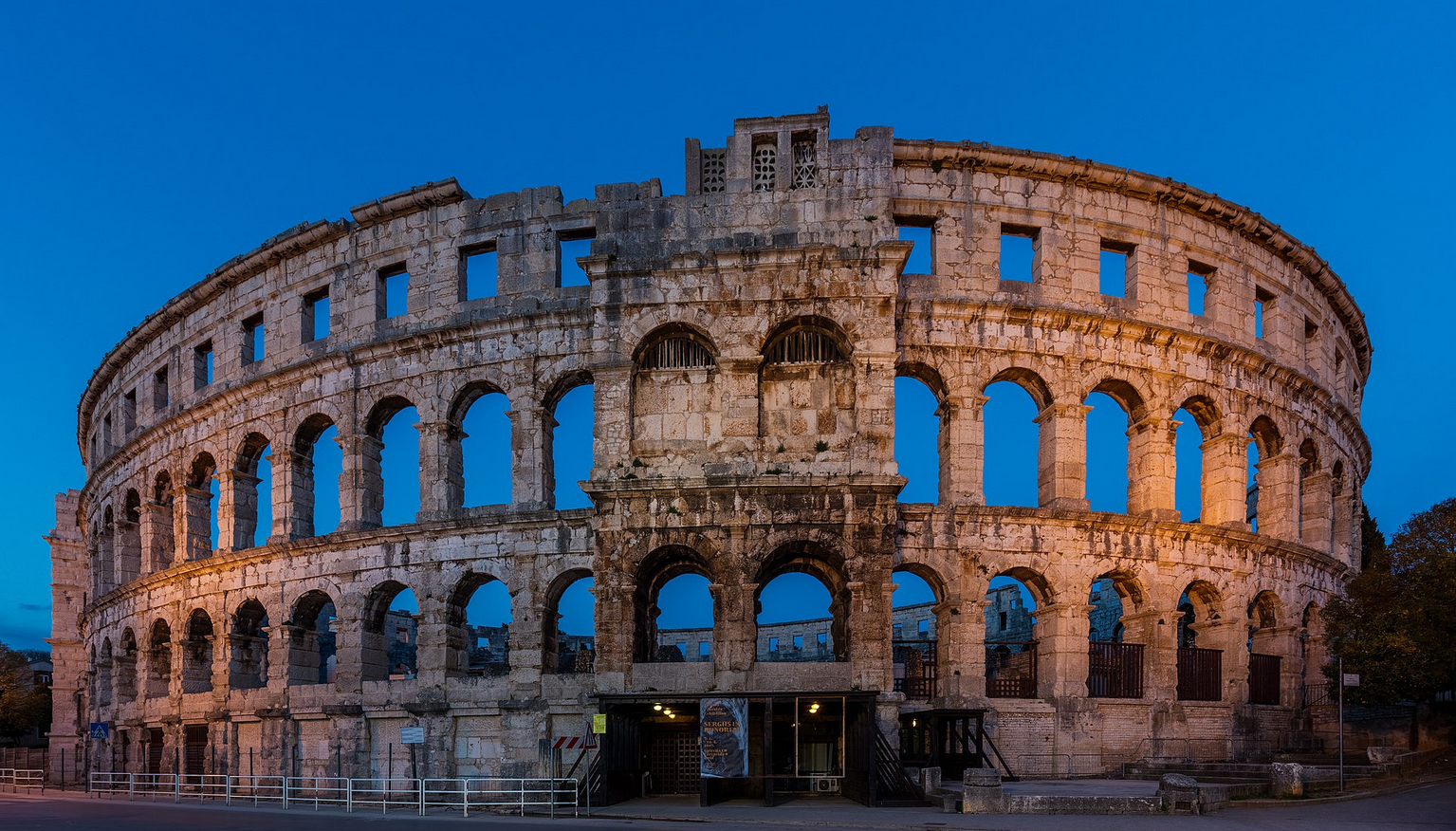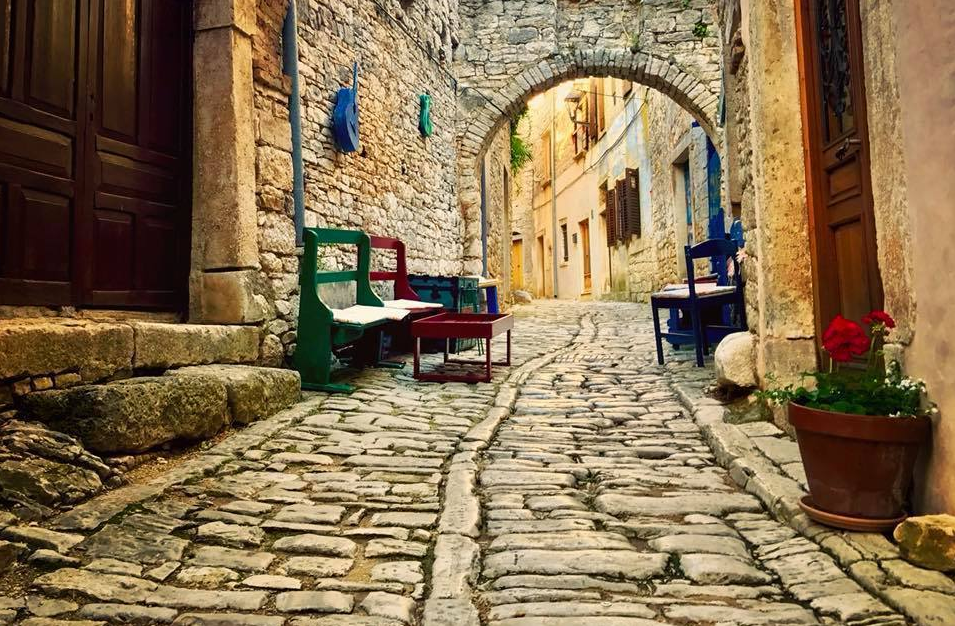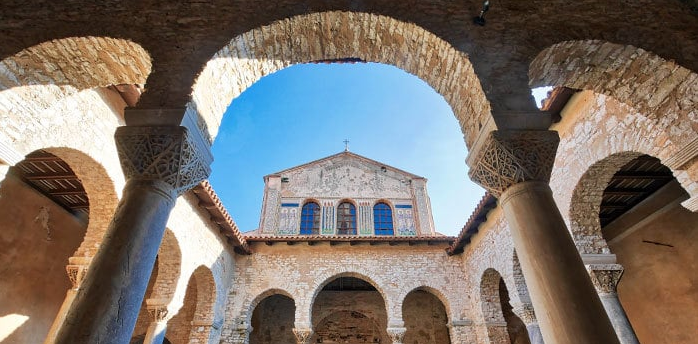Editor’s note: The following is extracted from The Shores of the Adriatic, by F. Hamilton Jackson (published 1908).
The name “Istria” is derived from the Istro, confounded by the ancient geographers with the Danube (Ister), and therefore supposed to be a branch of it. Considering the testimony of ancient writers as to the migration of Thracians, it appears probable that the Istrians were of these people, a band who left Pontic Istria by ascending the rivers Danube, Save, and Lubiana, crossed the Julian Alps, and descended to the Adriatic. Some such migration may be at the root of the story of the passage of the Argonauts, pursued by the Colchians. In the ninth century B.C. Ionians from Miletus settled colonies in Istria, who were followed by Corinthians in 735 B.C. It has been claimed that the name “Adriatic” is derived from Adar, the Asiatic sun-god, or god of fire. Plenty of stone implements and other prehistoric objects have been found in caves and burial places, and there are many Celtic place-names; the Celts arrived in the fourth or fifth century B.C., and contested the country with the older immigrants. Under Roman rule the two races ultimately intermixed, the Celts being in the majority.

The oldest inhabitants thus appear to have been of Pelasgic stock, Celto-Thracian. The Carnians were a branch of those of Lycaonia and Acarnania, who also settled in Gaul, and, according to Livy, mixed with the Etruscans during the reign of Tarquinius Priscus. They were sailors and merchants, but also pirates. When the Romans founded Aquileia they were forced to take measures to ensure safe navigation and to prevent danger to the new colony. Therefore, in 178 B.C., an expedition against the Istrians was undertaken under the Consul Aulus Manlius Vulso, but without the authorisation of the Senate, the army being transported by ship to the environs of Muggia. The Istrians attacked the camp in a fog, and, having driven the Romans to the shore, sat down to eat—and drink. While they were incapacitated in consequence, the Romans returned and killed most of them. The following year they entered Istria again, sacking and devastating the country. In the battle which followed, 4,000 Istrians were left on the field, and the rest took refuge in the cities, and asked for peace. The negotiations were broken off owing to the Consul Claudius proceeding in an irregular manner, and Nesactium was vigorously besieged with two fresh legions. A stream which defended the walls and supplied drinking-water was diverted by the Romans; its failure convinced the inhabitants that their gods were either powerless or angry, and during the final assault the despairing Istrians killed their women and children to save them from slavery, and threw their bodies over the walls. Epulus, the king, fell upon his sword when he saw the enemy within the walls; the rest either perished or were made slaves. Mutila and Faveria were also attacked and levelled with the ground, and quiet reigned in Istria. Livy says that at that time 5,622 persons were sold into slavery, the authors of the war were beaten and then decapitated, and Istria was garrisoned with Roman troops. In 129 B.C. the Istrians rose in revolt when Rome was occupied with the Gepid war. The Consul Caius Sempronius Tuditanus crushed this revolt, and after that colonies were established at Ægida (Capodistria), Æmonia (Cittanova), Albona, Parentium, Piquentum, Pola, Tergeste, and probably in other places. Many Istrians fled into the Karst region, and for a long time the land was unsafe. Julius Cæsar had to take measures to protect Tergeste from raids.

The Italianising of the country proceeded apace. Many Slav names occur in Roman inscriptions; but in 127 B.C. 14,000 Roman colonists arrived, and year by year more came, until the time of Augustus, both plebeians and patricians. Many of the latter of Istrian birth occupied important posts outside Istria; and, according to an ancient Aquileian breviary quoted by Dr. Kandler, many of the Christian martyrs belonged to patrician families. The names of SS. Euphemia, Thecla, Apollinaris, Lazarus, Justina, Zeno, Sergius, Bacchus, Servulus, and Justus may be quoted. The towns benefited in material ways, aqueducts were constructed to supply them with water, and fine roads, such as the consular road from Pola to Aquileia and Venetia, with its many branches, provided easy and rapid communication. There was traffic in wines, wood, marble, and granite. Istrian acorns nourished a fine breed of pigs which were exported to Rome. The purple-dyeing factories of Cissa near Rovigno, the fulling works of Pola and Trieste, and the potteries of Aquileia were known far and wide. Nor were philanthropic works neglected. Under some of the later Pagan emperors foundling hospitals and schools were established in separate provinces for orphans and poor children.

Under the just and wise rule of Theodoric the province flourished; but the people always regarded the Goths as barbarians, and when the Byzantines attacked Istria in 539-544 and 552 the troops of Vitalius, Belisarius, and Narses were welcomed. They called the Greek Government “Sancta Respublica,” and erected basilicas in gratitude for the freeing of the land from the Arian Goths. Justinian re-established the Roman constitution with certain alterations, among which was the power of appeal to the court of the bishop, which gave him control and surveillance over the municipal functionaries. His power was not supreme, however, the military defence of the frontier being equally important. For some sixty years the “Schism of the Three Chapters” rent this part of Christendom, and caused a great deal of ill-feeling and many questionable actions. It arose from the Emperor Justinian in 544 condemning (1) the writings of Theodore, bishop of Mopsnestia, who anticipated the heresy of Nestorius; (2) the writings of Theodoret, bishop of Cyrus, against the twelve anathemas of S. Cyril of Alexandria, and the decrees of the Council of Ephesus; and (3) the letter of Ibas, bishop of Edessa, to Maris the Persian. The Latin Church, with Vigilius the pope at its head, declined to accept the Imperial decree, which was in contradiction to the Council of Chalcedon of 451. In 548 the pope, while at Constantinople, was induced to repudiate them; but, on finding how strong the opposition was, revoked his agreement in 550, and induced the emperor to summon a council, which met in 553 and condemned the three chapters and their authors. The pope returned to Rome, and died there in 554, having confirmed the decision of the Council of Constantinople, and anathematised those who refused to accept it. Notwithstanding this, the bishops of Lombardy, Venice, and Istria, with the Aquileian patriarch Macedonius at their head, and other bishops, refused, and this refusal produced the “Istrian schism,” or schism of the “Tre Capitoli.” Paulinus, who succeeded Macedonius, called a synod at Aquileia in 557, which repudiated the decision of the Council of Constantinople. Pelagius II., who was then pope, called in the secular arm, but the descent of the Lombards in 568 stopped the discussion. Euphrasius of Parenzo was one of the principal supporters of Macedonius, and the pope did not hesitate to make the most disgraceful charges against him. In 578 Paulinus transferred the patriarchate to Grado, so putting himself under Byzantine protection. Elias of Grado held the same opinions as his predecessor, even excommunicating his adversaries. His successor, Severus, holding the same views, Smaragdus the Exarch made an expedition to Grado in 588, took Severus and the bishops of Parenzo and Trieste to Ravenna, and kept them there in prison for a twelvemonth, till they agreed to condemn the three chapters. When they returned they found their clergy would not go with them, so a synod was convened at Marano, and there they revoked their condemnation. Smaragdus, exarch again in 603, so arranged matters that on the death of Severus (who had preached revolt) Candidiano was appointed patriarch, a man who was devoted to the papal authority, and who reconciled himself with Rome, thus ending the schism. It had caused grievous disorders, the bishops being sometimes for and sometimes against it, and the clergy sometimes in strife among themselves and sometimes with the Patriarch of Grado; but the mode in which it was ended was quite as disgraceful as any of the deeds done during its course. In 610 armed Byzantine soldiers entered the basilicas and dragged three Istrian bishops from the altars, with menaces and vituperation, compelling them to accompany them to Grado, where they were forced to bend to the Imperial commands and reconsecrate Candidiano patriarch.

The Lombards re-established the patriarchate of Aquileia, electing Abbot John, who was opposed to the pope, and thus there was a double patriarchate. The Aquileian patriarchs only became reconciled to the papacy in 698 when the Lombards had ceased to be Arians. The Istrian bishops obeyed the Patriarch of Grado until the Council of Mantua (827), which decided that they should return to Aquileia. Istria was Lombard only from 751 to 788.
When Charlemagne conquered the country in 789 feudalism was substituted for the Roman autonomy with the co-operation of the higher clergy. The Frank duke was supreme, and his underlings had arbitrary power. Public property was confiscated for the benefit of the duke and his supporters, and all kinds of arbitrary and exorbitant imposts and restraints were imposed upon the people, even to the prohibition of fishing! The result was great discontent, and at last, in 804, by the intervention of Fortunatus, Patriarch of Grado, an inquiry was held at Risano, the acts of which were embodied in the “placito” of Risano. The envoys of Charlemagne restored the communal property and the jurisdiction over foreigners, exempted freemen from servile tasks, suppressed arbitrary imposts, and restored the tribunes and other Byzantine magistrates, whom the people were allowed to select freely according to the ancient custom. In 952 Istria became a German fief by gift of Otho I. of Germany (who had conquered Italy the year before) in feud to his brother Henry, duke of Bavaria, together with Verona and Friuli. Documents show the presence of large numbers of persons of German origin during the tenth century; but the maritime cities, depending upon commerce, were forced into connection with Venice by the necessity of making arrangements for mutual defence against Slav and Saracen Corsairs, and thus the foundations were laid for the Republic’s later supremacy.
A great part of the history of Istria relates to incursions by the barbarians, either beaten off, or successful, with the destruction of towns, and the carrying off of slaves and booty. The descent of the Lombards was followed by a raid of the Avars in 599, but they were beaten off. Three years later they came again in company with Slavs and Lombards. In 611 the Huns or Slovens descended on Istria, in 670 they were defeated near Cividale by Duke Vetturi, and in 718 were conquered in three battles near Lauriana by Duke Pemmo. His son Ratchis copied the bad example of the Huns, sacking and killing far into Carniola. Between 620 and 630 the Serbo-Croats descended from the Carpathians and crossed the Danube by suggestion of Heraclius, driving the Avars from Dalmatia and taking their place. The result of these constant barbarian raids was the concentration of the population in the towns on the sea-coast.
The pirates in the Adriatic were first the Narentans and next the Saracens, who devastated the coasts of Dalmatia in 840, fruitlessly besieging Ragusa for fifteen months, and afterwards taking Taranto and Bari. In 842 they defeated the Venetians at Taranto, and, on the octave of Easter, took Ossero and burnt it. They then passed on to Ancona and Adria, and as they returned captured a whole Venetian squadron. In 876 the Slavs of Croatia and Dalmatia raided the Istrian coast towns, but were defeated at Grado. The Emperor Basil occupied Dalmatia in 877 on the pretext of Slav piracy. He gave the tribute from the Roman cities of Dalmatia to the Croats and Narentans, so that Spalato, Zara, Traù, Arbe, and the Byzantine cities of Veglia and Ossero had to pay tribute to the Croats. The successful expedition of Pietro Orseolo II. against the Narentan pirates tended to the greater security of the coast towns and strengthened the bond which Venice was weaving.

In 933 a solemn treaty of peace was signed at Rialto between Istria and Venice by the Marquis of Istria, the bishops of Pola and Cittanova, two “locopositi,” two “scabini,” and twelve other trustees from Pola, Capodistria, Muggia, and Pirano, there convened. A fresh treaty was made in 977 with Capodistria, giving Venice special advantages, and these negotiations were carried on without reference to the Imperial authority, the nominal feudal lord. Walking thus warily, avoiding offence to the Emperor of Germany, Venice took 200 years of continuous political action to acquire the Istrian cities. By 1145 Venice had obtained for herself liberty of commerce in most of the Istrian towns and complete exemption from any kind of taxation; she had established at Pola and Capodistria a representative, to look after the punctual execution of treaties, and to protect Venetians from injustice, and had also made the Istrian cities pay her a tribute, either in money or products, obtaining also assistance for her navy from them whenever it was fighting beyond Zara and Ancona. The importance attached by Venice to these concessions is proved by the triumph which was given to the squadron of Morosini and Gradonico when returning victorious from Istrian waters. It was then that the doge assumed the title of “dux totius Istriæ,” but the dates of the dedition of the several cities are much later. The re-organisation of the communes took place between 1150 and 1180. The podestà had a council of assessors, the “consiglio minore”; the larger “consiglio del popolo” was called together for the more important matters, such as declaration of war, conclusion of peace, legislation, imposition of taxes, election of podestà and consuls, &c.; while many documents show that the whole body of citizens was summoned to a “parlamento” for the publication of new laws, very important deliberations requiring practical unanimity, the installation of fresh magistrates, &c. The “statute” was apparently drawn up when a foreign podestà succeeded to native consuls as an assertion of the ancient judicial custom. That of Capodistria, the earliest, is of 1238-1239; that of Pola, 1264. As soon as the communes began to extend their work of domestic supervision a “fontico” was established, a place where corn was sold at little above cost price. Everything was supervised—the time of vintage and of selling the new wine was fixed, the amount of bread to be baked in each oven was prescribed, the justices tasted the wine before the taverners began to sell, cut off the tails of fish unsold by the evening, and generally looked after the strict fulfilment of the regulations affecting food. As the vintage approached, the guards in the vineyards were doubled, and, from August 3, dogs were tethered to a stake to intimidate thieves. The prices of foreign goods were fixed and, before commencing to sell, merchants were obliged to expose their wares on the quays or in the piazza for three days. Standard measures were cut in stone in conspicuous places, and at Albona the various imposts were carved on the clock-tower in the piazza. Armed men were not allowed to enter the cities, and the officials interested themselves in everything going on, an example of which may be quoted from Pirano. When S. Francesco was built in 1301, the podestà carried the first stone on his shoulder, and set it in the ground before the assembled people. Venice succeeded the patriarch as overlord of the Istrian communes in 1420, and after this the history of Istria is merged in that of the Republic.

The ravages of the plague were fearful, and practically depopulated the province, returning again and again till 1631. In the fourteenth century it decimated the Brioni Islands; no less than five Benedictine convents were abandoned—three in Pola and one near Barbana d’Arsia, as well as that on the Brioni Islands. In Muggia an inscription states that half the population died in 1347. In 1361 Ossero was so devastated that two years later the bishop abandoned it and went to live in Zara. In 1371 the country round Pola was so afflicted that of seventy-two towns only eleven preserved their names, the rest disappearing without leaving any trace. In Cittanova in 1643 there were only ten inhabitants left, the bishop abandoned it to live in Buie or Verteneglio, and in 1686, as there were not enough citizens to constitute a council, they had to add strangers to make a quorum. Angelo Morosini, podestà of Capodistria in 1646, described it as “Goddess of desolation and refuge of solitude itself.” Parenzo was so severely smitten that only thirty persons remained. At Pola in 1631 there were but 300 persons left, including the garrison of foreigners, and of the citizens but three families. This was the last visitation.










